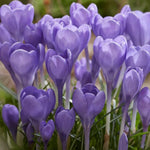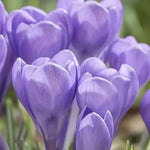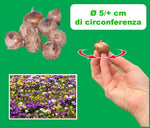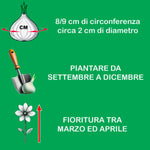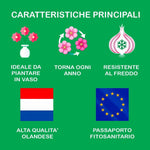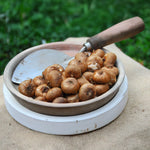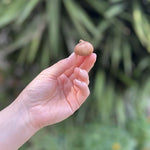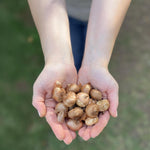-
Description
DESCRIPTION: Crocus tommasinianus 'Hummingbird' is a captivating and relatively recent variety of Crocus tommasinianus, also known as “Tommasini’s crocus,” a botanical species native to southeastern Europe. It is widely appreciated for its ability to naturalize easily and its early flowering, often already in bloom by February. This cultivar stands out for its unique and rich coloring, and — as the evocative name Hummingbird suggests — its flowers recall the iridescent and shimmering hues associated with these exotic little birds: vibrant, elegant, and full of life. 🌸 Appearance and Characteristics ‘Hummingbird’ flowers are slender and tapered, with silky-textured petals that open into a star or goblet shape. The coloring is particularly striking: A deep violet hue, with subtle metallic blue or purplish overtones depending on the light Inner petals are lighter, almost silvery near the base A vivid center of orange-yellow stamens that stand out beautifully against the darker background This elegant and understated variety brings a touch of mystery and refinement to the early spring garden. 📏 Size and Bloom Height: Around 8–12 cm (3–5 inches) Flower: Medium-small, but well-defined and very luminous Blooming period: Very early — late winter to early spring (February–March) 🌿 Cultivation ‘Hummingbird’ is easy to grow and well-suited even for gardeners with little experience with bulbs. Crocus tommasinianus is particularly known for: Naturalizing readily, forming increasingly dense colonies each year Tolerating harsh cold and snow Requiring little to no maintenance Ideal growing conditions: Planting time: In autumn, from September to November Exposure: Full sun or light partial shade Soil: Well-drained, even poor soils are fine, but avoid waterlogging Planting depth: 6–8 cm (2.5–3 inches) Spacing: 5–10 cm (2–4 inches) between corms 🌱 Where to Plant in the Garden ‘Hummingbird’ is ideal for: Naturalizing in lawns Soft borders along paths or flowerbeds Under deciduous trees, where it can bloom before the foliage casts shade Woodland-style or wild gardens Containers or pots, especially when combined with white or yellow varieties 🐝 Ecological Benefits As one of the first flowers to bloom in the year, it is crucial for early pollinators, especially solitary bees and bumblebees, which emerge from hibernation in urgent need of nourishment. 📌 Summary Crocus tommasinianus 'Hummingbird' is a small gem for the late-winter garden: elegant, hardy, early, and deeply colored. Perfect for lovers of rich violet hues and for those seeking a reliable, low-maintenance variety that multiplies naturally year after year. A refined choice to bring life and color to the garden when winter has not yet fully yielded to spring.
PACKAGE: The package contains 15 bulbs of Crocus tommasinianus 'Hummingbird'. The bulbs have a circumference of 5/+ cm (about 2 cm in diameter). The packaging features a beautiful illustrative photo and includes planting and flowering information, making it an excellent gift idea.
HOW TO GROW: Plant the bulbs about 8 cm deep in full sun or partial shade, either in pots or directly in the ground. Space the bulbs approximately 5 cm apart. Use rich, well-drained soil and water moderately. Plant the bulbs between September and December. Flowering will occur between February and April.
SELECTION AND QUALITY: The bulbs come with a phytosanitary passport and undergo a strict quality control process to ensure splendid blooms from the first year.
AFTER-SALES ASSISTANCE: Customer satisfaction is our top priority. We are available to assist you with any questions or concerns regarding your purchase. You can contact us via the Amazon messaging platform or our dedicated WhatsApp line.








